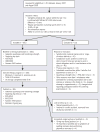A progressive 5-week exercise therapy program leads to significant improvement in knee function early after anterior cruciate ligament injury
- PMID: 20710097
- PMCID: PMC3158986
- DOI: 10.2519/jospt.2010.3345
A progressive 5-week exercise therapy program leads to significant improvement in knee function early after anterior cruciate ligament injury
Abstract
Study design: Prospective cohort study without a control group.
Objectives: Firstly, to present our 5-week progressive exercise therapy program in the early stage after anterior cruciate ligament (ACL) injury. Secondly, to evaluate changes in knee function after completion of the program for patients with ACL injury in general and also when classified as potential copers or noncopers, and, finally, to examine potential adverse events.
Background: Few studies concerning early-stage ACL rehabilitation protocols exist. Consequently, little is known about the tolerance for, and outcomes from, short-term exercise therapy programs in the early stage after injury.
Methods: One-hundred patients were included in a 5-week progressive exercise therapy program, within 3 months after injury. Knee function before and after completion of the program was evaluated from isokinetic quadriceps and hamstrings muscle strength tests, 4 single-leg hop tests, 2 different self-assessment questionnaires, and a global rating of knee function. A 2-way mixed-model analysis of variance was conducted to evaluate changes from pretest to posttest for the limb symmetry index for muscle strength and single-leg hop tests, and the change in scores for the patient-reported questionnaires. In addition, absolute values and the standardized response mean for muscle strength and single-leg hop tests were calculated at pretest and posttest for the injured and uninjured limb. Adverse events during the 5-week period were recorded.
Results: The progressive 5-week exercise therapy program led to significant improvements (P<.05) in knee function from pretest to posttest both for patients classified as potential copers and noncopers. Standardized response mean values for changes in muscle strength and single-leg hop performance from pretest to posttest for the injured limb were moderate to strong (0.49-0.84), indicating the observed improvements to be clinically relevant. Adverse events occurred in 3.9% of the patients.
Conclusion: Short-term progressive exercise therapy programs are well tolerated and should be incorporated in early-stage ACL rehabilitation, either to improve knee function before ACL reconstruction or as a first step in further nonoperative management.
Level of evidence: Therapy, level 2b.
Figures





References
-
- Ageberg E. Consequences of a ligament injury on neuromuscular function and relevance to rehabilitation: using the anterior cruciate ligament-injured knee as model. J Electromyogr Kinesiol. 2002;12:205–212. - PubMed
-
- Ageberg E, Thomee R, Neeter C, Silbernagel KG, Roos EM. Muscle strength and functional performance in patients with anterior cruciate ligament injury treated with training and surgical reconstruction or training only: a two to five-year followup. Arthritis Rheum. 2008;59:1773–1779. http://dx.doi.org/10.1002/art.24066. - DOI - PubMed
-
- Anderson AF, Irrgang JJ, Kocher MS, Mann BJ, Harrast JJ. The International Knee Documentation Committee Subjective Knee Evaluation Form: normative data. Am J Sports Med. 2006;34:128–135. http://dx.doi.org/10.1177/0363546505280214. - DOI - PubMed
-
- Bent NP, Wright CC, Rushton AB, Batt ME. Selecting outcome measures in sports medicine: a guide for practitioners using the example of anterior cruciate ligament rehabilitation. Br J Sports Med. 2009;43:1006–1012. http://dx.doi.org/10.1136/bjsm.2009.057356. - DOI - PubMed
-
- Beynnon BD, Johnson RJ, Abate JA, Fleming BC, Nichols CE. Treatment of anterior cruciate ligament injuries, part I. Am J Sports Med. 2005;33:1579–1602. http://dx.doi.org/10.1177/0363546505279913. - DOI - PubMed
Publication types
MeSH terms
Grants and funding
LinkOut - more resources
Full Text Sources
Medical
Research Materials

